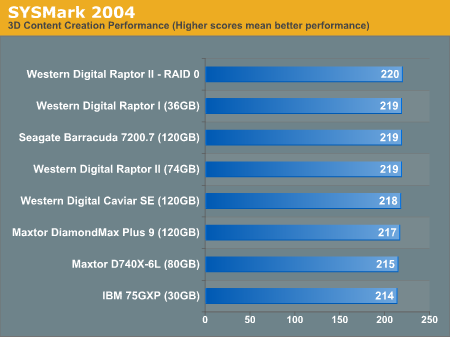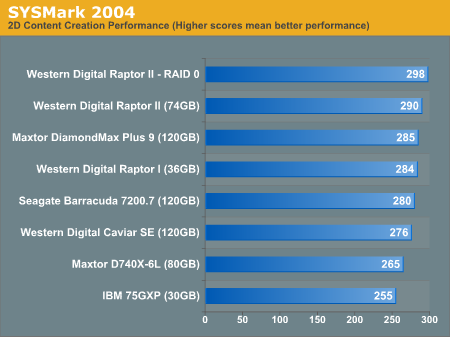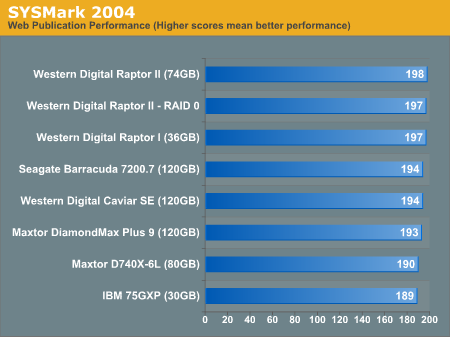Western Digital's Raptors in RAID-0: Are two drives better than one?
by Anand Lal Shimpi on July 1, 2004 12:00 PM EST- Posted in
- Storage
Overall System Performance - SYSMark
SYSMark 2004 is divided into two separate suites: Internet Content Creation and Office Productivity. What makes SYSMark an ideal hard disk benchmark is that its scores are totals of response times, meaning that the benchmark measures how long the system takes to respond to a task (e.g. how long before a search and replace is completed after it is initiated) and sums up all such response times to generate a score. This score is generated for six total subcategories: three under Internet Content Creation and three under Office Productivity.For the most part, SYSMark is CPU/platform bound, but we will see some variations in performance according to disk speed. At the same time, there are a couple of benchmarks within SYSMark that are heavily disk dependent.
First, we start with Internet Content Creation performance; the first category that we will deal with is 3D Content Creation. The tests that make up this benchmark are described below:
"The user renders a 3D model to a bitmap using 3ds max 5.1, while preparing web pages in Dreamweaver MX. Then the user renders a 3D animation in a vector graphics format."

As we've seen in the past, 3D content creation performance is rarely influenced by hard disk speed (unless your workstation is grossly underpowered in memory size), and thus, we see no improvement from a two-drive RAID-0 array.
Next, we have 2D Content Creation performance:
"The user uses Premiere 6.5 to create a movie from several raw input movie cuts and sound cuts and starts exporting it. While waiting on this operation, the user imports the rendered image into Photoshop 7.01, modifies it and saves the results. Once the movie is assembled, the user edits it and creates special effects using After Effects 5.5."

There's a small 2.8% performance boost from RAID-0 here, but once again, nothing to write home about and nothing worth the added cost.
The Internet Content Creation suite is rounded up with a Web Publishing performance test:
"The user extracts content from an archive using WinZip 8.1. Meanwhile, he uses Flash MX to open the exported 3D vector graphics file. He modifies it by including other pictures and optimizes it for faster animation. The final movie with the special effects is then compressed using Windows Media Encoder 9 series in a format that can be broadcast over broadband Internet. The web site is given the final touches in Dreamweaver MX and the system is scanned by VirusScan 7.0."

Once again, we're left with virtually identical performance between the RAID-0 and single drive Raptor configurations. The average of our three SYSMark runs have actually left the single drive Raptor II slightly ahead of the RAID-0 array, but that's normal variation between the benchmark runs.










127 Comments
View All Comments
Denial - Friday, July 2, 2004 - link
A$$ Masher,You seem to be the only person turned on by my system. Sorry, but I don't swing that way. You'll have a better chance at the internet cafes over in Chelsea.
TheCimmerian - Friday, July 2, 2004 - link
...Anyone have any thoughts on RAID0 for DV capture/editing/rendering?...masher - Friday, July 2, 2004 - link
#71, the statistics and applicability for MTBF and MTTF are a bit complex...so much so that most drive manufacturers themselves usually don't apply them properly (or intentionally mislead people).Technically, you're correct...RAID0 doesn't halve MTBF. However, for what the average user means by "chance of failure", a two-disk Raid0 array does indeed double your chance of a failure.
As to your comment of Raid-0 loading maps faster...true if its a large file (10MB+) and probably not discernably noticeable till you're in the 20-40MB range. For tiny files or heavily fragmented ones, it may even be slower.
Z80 - Friday, July 2, 2004 - link
This article was very informative. However, the statements that RAID0 cuts MTBF in half and that RAID1 doubles MTBF are statistically incorrect. Also, RAID0 does improve game performance especially when large game maps are involved (i.e., BF1942, BF Vietnam, Far Cry). It definitely provides an advantage in online FPS games by loading large maps faster and giving RAIDO equipped players an advantage in first choice for weapons and position. Your tests probably didn't measure map loading times.GokieKS - Friday, July 2, 2004 - link
"What's the difference between losing one 74gig Raptor in RAID-0 array or one 160gig stand-alone drive? THERE IS NO DIFFERENCE!"There is. The chance of you getting a HDD failure increases with every drive you add. A 2 disk RAID-0 array will have the same chance at failure as 2 independent non-RAIDed drives. The difference is, with the independent drives, you lose one drive's worth of data when it fails. With the RAID-0 array, you lose two.
~KS
sparky123321 - Friday, July 2, 2004 - link
I keep hearing about double the cost and the additional risk associated with a RAID-0 array.First off, double the price gets you DOUBLE the capacity of a single drive. It's a wash price wise. On top of that, you increase disk performance by up to 20+%. Normally, there tends to be a decrease in performance as capacity increases when comparing similar generation drives.
Secondly, with regard to risk. What's the difference between losing one 74gig Raptor in RAID-0 array or one 160gig stand-alone drive? THERE IS NO DIFFERENCE! If you don't have a recent backup, you've lost everything. Just spend an additional $90 to buy a backup 160gig 7200rpm IDE and use Acronis to do a complete disk mirror every week or two. If you lose a RAID-0 drive, you can just boot off of the backup drive and be up and running in a matter of minutes. Worst case, you've lost you're most recent work only.
Power to the Raptors and I think I'll stick with my RAID-0 array!!!!!!!
abocz - Friday, July 2, 2004 - link
I think #63 summed it up pretty well. For most real world usage the RAID0 setup never gets to shine because of the ratio of seek times/data transfers. Lower (7200) RPM drives will only compound the situation since their seek times are worse. Finally, add to this phenomenon the fact that the ratio of seeks will increase over time as fragmentation increases.Which begs the question of how well defraggers work in a RAID 0 setup? Anybody know?
Inferno - Friday, July 2, 2004 - link
Maybe you should try this test with some lesser drive. The raptors are kind of the be all end all drives. Maybe a pair of midrange Maxtors.binger - Friday, July 2, 2004 - link
#61, jvrobert is right in saying that the advantages of a raptor-raid0 are restricted to faster boot-up times and smoother handling of very large files, eg when it comes to dv.although i have heard similar statements before, whether a raid0-array of two 160gb samsung drives comes close to the performance of a single 74gb raptor drive, i don't know - i would surely appreciate being pointed to an appropriate review or at least a couple of significant benchmark results.
jvrobert - Friday, July 2, 2004 - link
Two points:First, it doesn't matter much what card you use for RAID 0. There's no parity calculation, so onboard hardware won't help much. Probably Windows striping, Intel RAID, VIA RAID, Highpoint RAID, etc.. are within 1 percent of eachother.
Second, this is a limited test that comes to an overgeneralized conclusion. As some have mentioned - these are raptors. I have a single raptor as my OS disk. Where RAID helps is with slower drives - you can get a "virtual" raptor of e.g. 360GB by buying 2 cheap, quiet, cool Samsung spinpoints.
Third (OK, 3 points) - it only tests games (which don't use much hard disk IO) and business (again, disk speed doesn't matter much). I'm getting into video now, and RAID 0 will certainly improve performance there. It will also help with load times of the OS and of large applications.
So the article comes to an over-general conclusion limited on a few quick tests.